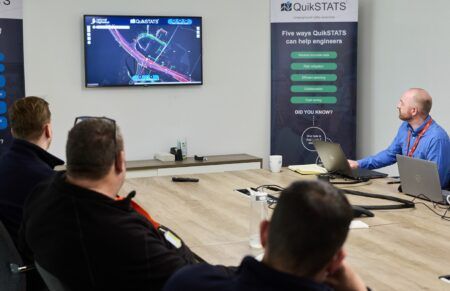The Rhode Island Department of Transportation (RIDOT) is partnering with Kistler, a provider of dynamic measurement technology, to develop the largest digital weigh-in-motion (WIM) site in the world on the Washington Bridge, a vital bridge in the city of Providence.
Kistler will provide RIDOT with state-of-the-art technology solutions to monitor and protect the structural health of the Washington Bridge, including 40 Lineas digital quartz sensors covering 10 traffic lanes.
Currently, the north span of the Washington Bridge is being removed and a new span is planned. To keep traffic moving during the north span restoration project, two traffic lanes were added to the south span.
Though the load rating on the south span is adequate, with the installation of structural health monitoring solutions (SHM) from Kistler, RIDOT will be able to evaluate the health of the south span in real-time to assess any potential adverse impact from the additional traffic load and enable proactive mitigation of variations in its structural health.

Comprehensive sensor based SHM solutions from Kistler offer real-time data for bridge structural condition monitoring to enable RIDOT to perform predictive analyses and more timely preventative maintenance. Included is a customized Kistler Digital Weigh In Motion (WIM) system to provide real-time evaluation and monitoring of precise bridge traffic load, as that information impacts the structural health of each bridge.
Kistler will outfit the bridge with measuring equipment, including accelerometers, strain gauges, temperature sensors, inclinometers and a meteorology station, to measure, collect and interpret bridge health data, and a WIM system to monitor specific load conditions.
For the SHM system, all hardware will be installed on the bridge based on engineers’ assessment of structures most likely to experience strain and to diagnose areas in need of repair. For example, while a bridge was built to vibrate and move, accelerometers can measure just how much and whether the movements are within the range of normal specified for that structure. If undue stress is detected by the sensors in real-time, the RIDOT team can implement measures to preserve the bridge’s structural integrity and health.
The WIM system includes Lineas Digital quartz sensors from Kistler placed just under the surface of the bridge’s roadway, charge amplifiers to condition electrical signals from the sensors, data loggers to process data in real-time and LPR cameras positioned to identify trucks by their class size and monitor for overweight wheel, axle and gross vehicle weight (GVW) loads.
The Kistler SHM and WIM systems are connected to share critical data and paint a picture of the bridge’s overall structural health in real-time. With this integrated data, bridge engineers and analysts can work with data on exact loads, axle weights and truck class to monitor the weight of trucks going across the bridge, as well as multiple measurements that assess the loads on the bridge structure to assess predictive maintenance requirements or be alerted to the need for emergency repairs.
“Bridges talk to us,” said JT Kirkpatrick, head of sales, Traffic Solutions, Kistler. “With Kistler’s Digital Weigh In Motion sensors, we have the ability to hear and interpret every sound, even nearly inaudible sounds, emitted from a bridge that signal structural distress. This will enable us to work with RIDOT to proactively monitor the bridge’s structural health in real-time so they can take action to preserve this vital structure.”





